After three other tourists, and Steven and I were picked up for a 4x4 jeep tour we'd arranged several days earlier, we were driven to the southern part of Bora Bora by Alex, our guide.
Thank goodness Alex was very adept at driving the jeep up the extraordinarily steep hill as he came close to stalling out a few times.
At the top of the hill, Alex pointed out the ring of motus or islets that surrounded Bora Bora. He told us that all native (yes, that was the word he used instead of indigenous) Bora Borans have two homes, one on the main island and a second on a nearby motu. People use it on the weekends to follow the traditional way of life by cooking coconuts and pigs in the ground for six hours. In the distance was Taha'a or Vanilla Island on the left. Raiatea on the right was also known as both Open Sky and Sacred Island.
Alex said two thousand different native families live on Bora Bora Pearl Beach motu which is divided into two thousand plots that the government cannot touch because there are no regulations or laws there. He added that natives own 42% of all land in Bora Bora.
As we'd learned before, Alex told us that Po Pora is the 'real' name of the island so he'd never say "Welcome to Bora Bora." The name was changed because explorers could never pronounce Po Pora. Bora Bora was also known as Vavau as of three generations ago.
We were standing on a crater where a volcano had erupted five to six million years ago.
As we then drove north through Vaitape, Alex said it was the 'only' place on the island that had a pharmacy or grocery store and that it was the Washington, D.C. of Po Pora!
Seeing the Bora Bora Home Depot made us feel right at home after all the renovations we just made to our home!
The "tour" continued to the northern part of the island which was largely desolated. I intentionally used quotation marks around the word 'tour' because, frustratingly, there was no mention by Alex of anything we were seeing.
I wish I had asked Alex what he meant when he talked about Faanu being the second village on the island after saying just a bit before that Vaitape was the only one on the island. Faanu was also known as American City because more than three thousand US soldiers lived in tents along this road around the bay during World War II.
American officers lived in the white house.
The first port was built by the Americans where the remaining pylons were still visible in the water. The second port was built across the bay where we spotted the red roofs so merchandise could be brought in on cargo ships from Tahiti. Americans set up a refueling and regrouping base in 1942 for shipping between the west coast of the US and Australia and New Zealand.
Alex seemed pretty disgusted that the French who considered French Polynesia their territory contributed none of the island's infrastructure. It was the American GIs who built the ports, constructed the 20-km road around the island, and, by 1943, also the first airfield in the South Pacific, the current airfield on Motu Mute. There was no wonder that the island was referred to as American Island! The French, according to Alex, did nothing but "talk, talk," and only twenty years later built an airport in Tahiti.
When Alex asked the five of us if we were interested in learning how a pareo, the local garment worn by both men and women on Bora Bora, was tied, we all expressed interest. I don't think any of us realized, though, that meant a fairly hard-core sell for us to buy ones made by this woman. Alex said he was proud to wear the pareo instead of a T-shirt and shorts or pants.
I was very surprised that it took only about 10 minutes max for the woman to take us through the steps of making a pareo which she sold for $15 each. She used the tie-dye method, placing the fabric in several colors one by one and then laying the Chinese-made fabric out on a large table. Immediately, she placed stencils on the patterns made by tie-dying to leave their mark.
The pareos she'd made were definitely colorful and attractive but they weren't something I'd likely wear elsewhere.
Only then did Alex actually take a couple of minutes showing how to tie or wear the pareo for both men and women.
If we thought the road up to the crater had been steep, Alex really showed his mettle when he began driving up the steepest road I think we'd ever been on! We had to brace our feet to make sure we didn't fall out the back. That was after Alex had assured us there was no need to wear seatbelts in his jeep because he "knew everyone" on the island by which we figured he meant the police!
At Tereia Point one American naval gun remained on the hillside with the housing of a second gun nearby. Remains of eight huge naval guns that had been placed on the island to defend against a surprise Japanese attack were still visible. Po Pura was easy to defend against the Japanese during the war because there was only one channel in and out of the island. Fortunately, that attack never materialized.
Alex explained that his grandfather was the first mixed-race baby born on the island after the American GIs stay on the island. I didn't think of it at the time but I wonder now whether that may have accounted for his definite pro-American bias during his spiel.
Alex mentioned these large leaves from the purau tree were once used as plates.
Alex told us we should know that we were looking at the island's north side because two colors of the sea were visible from Tereia Point. The dark blue was the deeper water which obviously meant the turquoise was the shallow water! I could have stayed glued to this spot forever and a day, it was so unbelievably stunning.
This photo clearly shows part of the ring of motus that surrounded the island.
A young American honeymooning couple on the tour with us were staying at one of these overwater bungalows.
The steep track down to the coastal road:
That effectively was the end of the tour as Alex just drove around the rest of the island without telling us a thing about what we were seeing. To look on the bright side, the views from the back of the jeep were simply breathtaking but it would have been nice to learn about other areas of the island.
I read later that just beyond the small boat harbor that had been home to the former American base was Marae Fare Opu which featured petroglyphs of turtles carved into the stones. Turtles had been selected because they were the favorite food of gods. Why oh why didn't Alex see fit to include a stop there?
Seeing the church, Steven and I would really have loved to know Alex's views about the religions and churches on Bora Bora and French Polynesia generally but there was no opportunity. The tour had been rated pretty highly but we found it disappointing because there was so much more Alex could have and should have included in our opinion.
After being dropped off a bit later, Steven and I went for another bike ride as I was curious about doing some souvenir shopping. I hoped to buy some Tahitian pearls for myself on Bora Bora but didn't see any that were the perfect combination of price and style. There were several attractive but very pricey galleries, however.
Curious about religion in French Polynesia, I read that ninety percent of Polynesians are Protestant because English missionaries came out in the 1600s to share their faith and tell the natives they shouldn't be idolizing earthly idols, but rather only God in the sky and heaven above. Because French missionaries came much later, just five percent of the churches are Catholic. The remaining five percent are evangelical Seventh-day Adventists and Mormons who arrived in the islands much later. In Vaitape, the largest church was this Evangelical Church.
Another evacuation route should conditions require it:
Next to our villa was a very small, possibly family, cemetery that I walked through for a few minutes.
Next post: A picture-perfect last day on Bora Bora.
Posted on January 22nd, 2022, from back home in chilly Denver after a wonderful few days away in hot Palm Springs. We're already looking forward to getting back to more reliably warm weather in about a week's time when we head to Phoenix, Arizona, for all of February!




















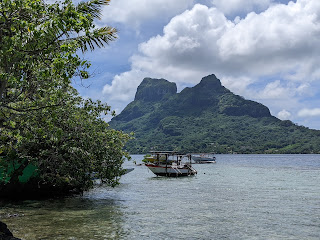








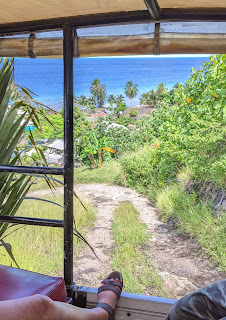








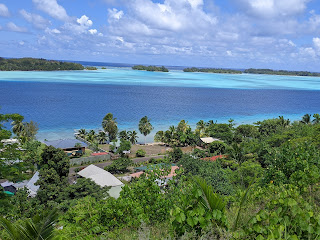










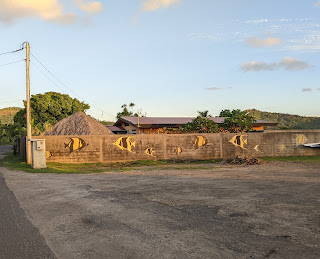



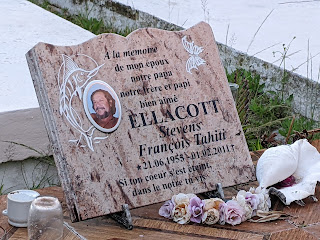
I agree with your description of the two side-by-side defined and distinct colours of the sea.. unbelievably stunning.
ReplyDeleteIncredible views, weren't they!
ReplyDeleteI've been up that really steep hill!!! Coming down was equally scary. Yes, beautiful views from the top. This is reminding me of our wonderful time in the So Pacific Islands. Janina
ReplyDeleteGlad my photos of the incredibly steep hill to get to the old American naval guns brought back such vivid memories of your own time in Bora Bora, Janina!
ReplyDelete